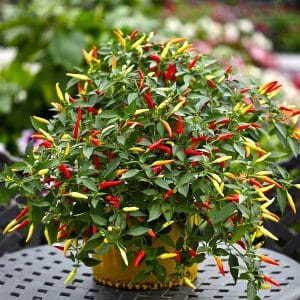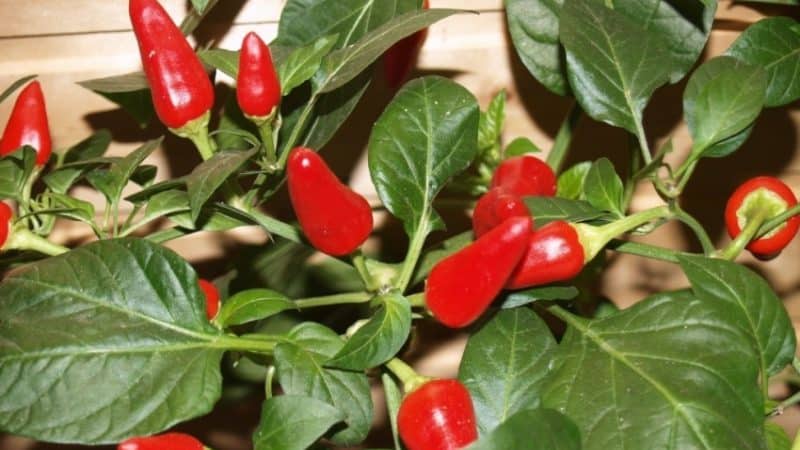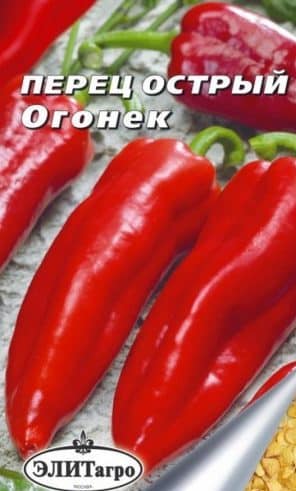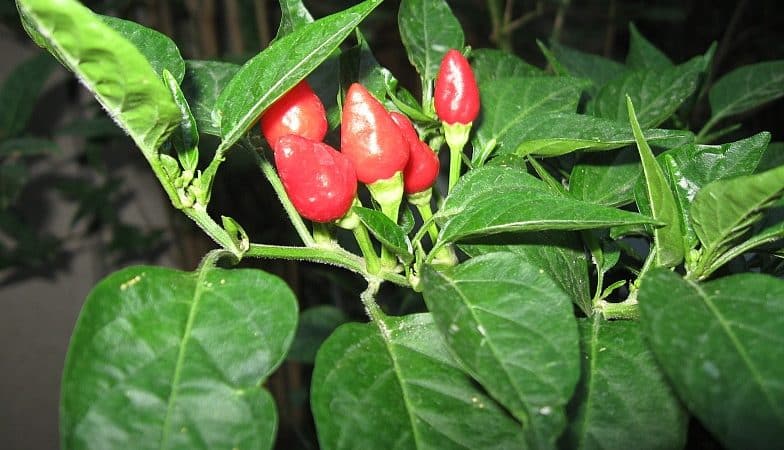What is good about the Ogonyok pepper variety and how to grow it correctly at home
Hot pepper is the most popular spice that stimulates the appetite and makes the taste of food more rich and interesting. The popularity of hot pepper is due not only to its wonderful taste. Its fruits benefit the body and are often used for medicinal purposes.
Ogonyok pepper is considered one of the hottest varieties of this plant. It is grown not only by gardeners in their plots, but also by indoor plant lovers. How to cultivate Ogonyok at home and what it is used for - read on.
General description of the variety

Ogonyok pepper is a variety that is distinguished by its increased pungency of fruits. It was obtained by crossing the world famous chili and cayenne pepper.
Mexico is considered the birthplace of Ogonyok. It was brought to Europe by Columbus.
Ogonek is a perennial plant. On the windowsill and in heated rooms greenhouses it is capable of growing for more than 8 years.
The fruits of the fire are small, but bright and beautiful. They come in red, brown, yellow, orange and purple. The taste is very bitter, with a pleasant sweet and sour aftertaste.
Small bushes of this variety look very decorative. They produce a large number of colorful peppers.
It is interesting that peppers growing on the same bush differ from each other not only in color, but also in shape. They are oval, round and pointed at the tip.
Ogonyok is not only a tasty, but also a healthy seasoning if consumed in moderation.It helps strengthen vascular walls, cleanses the body of cholesterol, free radicals, waste and toxins, improves the functioning of the brain and immune system.
Main characteristics
Ogonyok pepper is suitable for growing not only in the garden, but also at home. This is possible thanks to its characteristics:
| Parameter | Indicators |
| Bush type | Determinant. Grows up to 25-35 cm in height. The bush is well leafy, with not very thick but strong stems. The leaves are small in size, dark green in color, simple, smooth and shiny. The inflorescences are also simple. |
| Growing method | It is possible to grow in open ground and in greenhouses. In our country it is often cultivated as a houseplant. |
| Productivity | High. Up to 100 peppers are harvested from one plant per season. |
| Fruit | Small size. One fruit weighs 20-30 g. Oblong or round in shape. The tip can be pointed or round. The walls are dense. The color is red, brown, yellow, orange or purple. The taste is spicy, with a sweet and sour aftertaste. |
| Transportability | High. The fruits do not spoil when transported over long distances and are stored for more than 2 months. |
| Ripening time | Mid-season. The fruits ripen three months after sowing the seeds. |
Advantages and disadvantages
Light pepper - favorite variety Russian gardeners. It has many advantages:
- suitable for growing in open ground, in greenhouses and at home;
- decorative appearance of bushes;
- beautiful colorful fruits;
- high content of useful microelements;
- able to grow and produce crops for several years in a row;
- easy to plant and care;
- has excellent taste;
- Suitable for transportation and long-term storage.
This pepper also has its drawbacks. And before you plant it at home, you should familiarize yourself with all the nuances:
- does not tolerate sunlight well despite the fact that it is a light-loving crop;
- unstable to temperature changes;
- in windy weather the leaves begin to turn yellow and fall off.
How to grow Ogonyok at home

Ogonek is planted not only in greenhouses and open ground. It is also grown at home on the balcony. or windowsill. Thanks to its compact bush and bright fruits, it will play the role of a decorative houseplant.
It is not difficult to grow Ogonek at home. If you follow all the rules of care and follow the instructions for planting, then even a novice gardener can cope with the agricultural technology of this crop.
The bright fruits of this variety are convenient to pick from a bush standing on the windowsill. In such conditions it will produce crops all year round.
What you need to grow peppers

To grow peppers at home, you need a minimum of tools and materials.
You can buy them in gardening stores or prepare them yourself:
- Seeds. Both planting material from the factory packaging and seeds from ripe fruits are suitable.
- The soil. You need light and nutritious soil.
- Capacities. If you plan to grow Ogonyok at home, keep in mind that periodically the plant will have to be replanted into containers with a larger volume.
- Drainage. Broken ceramics, expanded clay, brick, small crushed stone and shell rock are suitable.
- Tool for loosening the soil. There are special miniature rakes for indoor plants, but a regular fork will do.
- Watering can with a thin spout. It is more convenient to water plants at the root.
- Spray.
- Feeding preparations and preventive treatment of plants.
- Fluorescent Lamp. It will be needed in winter, when there is not enough natural light for the pepper.
Optimal conditions and suitable location
Pepper Ogonyok is susceptible to environmental conditions. To get a rich harvest of pungent fruits, such a houseplant needs to find a suitable place.
Peppers are usually grown on a windowsill. It is better if the selected window faces southeast or southwest. In this case, the plant will have enough natural light, but it will not be exposed to direct sunlight.
To grow peppers, choose a well-lit, but not too warm place. The optimal temperature for this crop is considered to be 17-22ºC. If the room is too hot, the pepper begins to shed its leaves.
Processing of planting material
Before you start sowing seeds, the planting material must be processed. This will prevent plant diseases and speed up the appearance of the first shoots.
How to prepare seeds for planting:
- Seeds are checked for germination. They are sorted through, removing damaged and darkened specimens. They are then soaked in a salt solution. It is prepared from a glass of water and a teaspoon of salt. After half an hour, the floating seeds are thrown out, and the sunken seeds are used for planting.
- Planting material must be treated with a disinfectant solution. To do this, it is immersed for 20 minutes in a solution of potassium permanganate prepared from 2 g of potassium permanganate and 200 ml of water.
- Then the planting material is germinated. The seeds are wrapped in pieces of gauze moistened with warm water, placed in a saucer, covered with film and placed in a warm place. When the planting material swells and germinates, begin planting it. Instead of ordinary water, a growth stimulator is sometimes used.
Nuances of choosing containers and soil
For peppers use light and nutritious soil. Stores sell universal soil mixtures for growing seedlings and special soil for peppers, eggplants and tomatoes. Both options will do.
Many gardeners prefer to prepare the soil mixture themselves. To do this, you need to mix peat, humus, black soil and sand in equal proportions.
To sow seeds, use wide, shallow containers or individual peat tablets. For the first picking of pepper, take 300 ml pots. The last time during the season the plant is transplanted into a container with a volume of at least 1.5 liters.
To successfully grow peppers, drainage is essential. Broken bricks, expanded clay, pieces of ceramic ware, shell rock or small crushed stone are suitable.
Containers, soil and drainage must be disinfected. To do this, just pour them with a hot dark pink solution of potassium permanganate.
Planting pepper
The best time to sow seeds is the end of February or the beginning of March. Even at home during the winter season, the germination rate of planting material decreases.
Drainage is poured into the bottom of the containers. Soil is poured on top and moistened with warm water.
When sowing seeds in a common container, grooves 1 cm deep are made in the soil. Planting material is placed in them at a distance of 2 cm from each other. The depressions are covered with soil. Cover the containers with film and put them in a warm place.
If you plan to grow 1-2 plants on a windowsill, then it is most convenient to sow the seeds in peat tablets. In this case, you will only need one pick, during which you will not need to remove the tomato from the container.
Peat tablets need to be prepared by soaking them in boiling water for several hours. During this time, they will absorb water and swell. 1 seed is planted in the resulting bags.
Caring for Ogonyok
To grow pepper on your windowsill and not run into problems, you need to properly care for it:
- When the first shoots appear, the film is removed. The pepper is moved to a well-lit place. This plant requires a minimum of 12 hours of daylight. In winter and autumn, a fluorescent lamp is used.
- Water the pepper at the root as the soil dries. It is sprayed with water from a spray bottle 2-3 times a week.
- After each watering, the soil is loosened. To do this, use a special tool or a regular fork.
- When 2 true leaves appear, the peppers are planted in separate pots. At the end of spring, the plant is transplanted into a container with a volume of 1.5 liters. Be sure to add soil to the bottom of the pot.
- Peppers grown at home are fed once a month. Nitrophoska, Mortar, Kemira, chicken manure and mullein are used as fertilizers. Organic and mineral fertilizers alternate. Before applying fertilizers, the soil is moistened with plain water.
- Peppers growing in a pot do not need to be shaped. Even if you don't pinch it, it won't grow more than 35 cm.
- Ogonyok fruits set without artificial pollination. But artificial pollination will significantly increase the yield of the variety. To do this, use a soft, dry brush to go over each flower on the bush.
- Once every two years, the pepper is transplanted into a container that will be 1 liter larger than the previous pot. In a cramped container, the plant will stop growing.
Diseases and pests
During the process of growing peppers, you need to regularly inspect the bushes for suspicious changes. They indicate that the plants have been affected by diseases and pests:
- Leaves peppers turn yellow and crumble, and the stems lose turgor. Often this sign indicates rotting roots.This problem occurs when using ice water or excessive soil moisture. To correct the situation, you need to dig up the bush, wait for its roots to dry and replant it in new soil.
- Spider mites and aphids usually get on peppers from the street or from other indoor plants. To get rid of insects you need to prepare an infusion of 3 hot peppers, a liter of water and 1/5 of a piece of laundry soap. The composition is infused for 3 days, shaking occasionally. Then the liquid is filtered and the pepper and neighboring plants are sprayed with it.
- If the leaves begin to turn red and fall off, it means the pepper is not getting enough light. To remedy the situation, use a fluorescent lamp.
- If the bush does not bloom, it may be suffering from an excess of nitrogen fertilizers.
Harvest and storage
The first fruits of Ogonyok will ripen 3 months after sowing the seeds. They do not have to be picked immediately after ripening. They are stored on the bush for quite a long time.
After collection, Ogonyok is stored in a dry, dark place or in the refrigerator. In both cases it will last more than 2 months.
How to grow Ogonyok in open ground

Light peppers are also grown in open ground. In this case, its seedlings are prepared at home and planted in the garden when the height of the bush reaches 20 cm. This is done in early June or late May.
In open ground, the height of pepper sometimes reaches 1 m. The bush is tied up only if the plant tends to the ground.
Water the pepper early in the morning or at sunset. Feed it every 2 weeks. Chicken manure is used as fertilizer.
It is important to regularly weed the pepper beds while the weeds have not yet grown and their roots are not yet strong. Mature weeds will damage the roots of cultivated plants.
The beds are mulched.Straw, hay or humus are used as mulch. This measure is necessary to protect peppers from frost, diseases and pests.
Use in cooking
Ogonyok pepper is a wonderful spice that makes the taste of many dishes more piquant. There are many homemade recipes with this ingredient. Below are the most popular ones.
Recipes with Ogonyok:
- Pickled pepper. The peppers are washed, pierced in several places and placed in a half-liter jar. Pour 2/3 cup of sugar and 2 tbsp into the same jar. l with a hill of salt. The rest of the volume is filled with table vinegar. Close the jar with a screw-on lid and put it in the refrigerator or pantry. After a month, the pepper will acquire an interesting taste and become less spicy, and the brine will be saturated with aroma and spiciness. This preparation can be stored for several years.
- Dried pepper. The fruits of the fire are washed, wiped with a paper napkin and placed in a warm place for 2-3 days. Then the pepper is placed on a thread, which is tied in a dry, dark place. This narrowed pepper is crushed and used as a seasoning or to make flavored oil.
Reviews
Ogonek is liked by all housewives who love spicy food. Reviews about it are mostly positive.
Julia, Dnepropetrovsk: “This is not the first year I have been growing Ogonyok at home. In winter on the windowsill, and in summer on the balcony. Very spicy but tasty. During fruiting and flowering, the bushes look beautiful. I add peppers to food, marinate them and eat them raw.”
Igor, Krasnoyarsk: “Last year I planted Ogonyok at home. I grow it in a large pot on the windowsill. The plant does not require special care. I feed it only 2 times a month. The peppers are small, but very spicy. Just 1-2 pieces will make your food spicy.I like".
Conclusion
Ogonyok pepper is a great option for all spicy lovers. It is suitable for growing not only in open ground, but also on the windowsill. In the second case, it also pleases with high productivity.
Growing Ogonyok is not difficult. By observing all the rules and following the instructions, any amateur gardener can cope with this task.